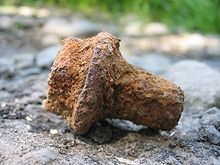|
|
| |
|
|
| |
|
|
|
|
| |
 |
| Oxides, such as
iron(III) oxide or rust, which consists of
hydrated iron(III) oxides Fe2O3·nH2O and
iron(III) oxide-hydroxide (FeO(OH), Fe(OH)3),
form when oxygen combines with other elements. |
Redox
Redox (reduction–oxidation, pronunciation: /ˈrɛdɒks/
redoks or /ˈriːdɒks/ reedoks) is a type of chemical
reaction in which the oxidation states of atoms are
changed. Redox reactions are characterized by the actual
or formal transfer of electrons between chemical
species, most often with one species (the reducing
agent) undergoing oxidation (losing electrons) while
another species (the oxidizing agent) undergoes
reduction (gains electrons). The chemical species from
which the electron is removed is said to have been
oxidized, while the chemical species to which the
electron is added is said to have been reduced. In other
words:
Oxidation is the loss of
electrons or an increase in the oxidation state of an
atom, an ion, or of certain atoms in a molecule.
Reduction is the gain of
electrons or a decrease in the oxidation state of an
atom, an ion, or of certain atoms in a molecule (a
reduction in oxidation state).
Many reactions in organic chemistry are redox reactions
due to changes in oxidation states but without distinct
electron transfer. For example, during the combustion of
wood with molecular oxygen, the oxidation state of
carbon atoms in the wood increases and that of oxygen
atoms decreases as carbon dioxide and water are formed.
The oxygen atoms undergo reduction, formally gaining
electrons, while the carbon atoms undergo oxidation,
losing electrons. Thus oxygen is the oxidizing agent and
carbon is the reducing agent in this reaction. |
|
|
The term redox comes from the two concepts of reduction
and oxidation. It can be explained in simple terms: |
- Oxidation describes the loss of
electrons by a molecule, atom or ion
- Reduction describes the gain of
electrons by a molecule, atom or ion
|
|
Whether an electron is gained or lost can be easily
memorised by the abbreviation OIL RIG, which stands for,
"Oxidation Is Loss," or losing electrons, and "Reduction
Is Gain," or gaining electrons. Redox reactions can also
happen by sharing electrons to form a product by
covalent bonding.
In an oxidation reduction reaction, the cation gives an
electron to the anion because both ions will have a
different charge to attract each other with. In an
oxidation reduction reaction, the oxidizing reagent
pulls an electron from the other atom to have a net
positive charge. The reducing reagent gives an electron
to have a net negative charge. However, there are
exceptions. |
|
|
|
|
|
|
|
|
|
|
|
|
|
|
|
|
|
|
Search Fun Easy English |
|
|
|
|
|
|
|
|
|
|
|
|
|
|
|
About
Contact
Copyright
Resources
Site Map |